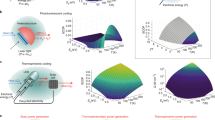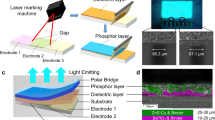Abstract
Conventional light-emitting diodes (LEDs) face an efficiency droop at low current due to non-radiative recombination overtaking radiative recombination at low carrier density. To overcome this universal problem, we develop LEDs with high efficiency at ultralow current and voltage, using a novel quantum well design and high-quality interfaces to suppress non-radiative recombination and enhance radiative recombination. The device exhibits close to unity internal quantum efficiency at a low current density of <1 × 10−4 A cm−2, more than three orders of magnitude lower than conventional LEDs. The LED bias voltage is reduced to ~30% below the photon voltage (hν/q). Wireless communication is demonstrated at these low-power conditions, which enables new applications in smart dust and sensor networks1,2,3,4,5,6, low-cost block chain and authentication7,8,9, medical applications10,11 and wherever high efficiency at low power is needed. New phenomena such as high-efficiency electroluminescent cooling becomes possible as the LED unity internal quantum efficiency extends to smaller voltage and current.
This is a preview of subscription content, access via your institution
Access options
Access Nature and 54 other Nature Portfolio journals
Get Nature+, our best-value online-access subscription
$29.99 / 30 days
cancel any time
Subscribe to this journal
Receive 12 print issues and online access
$209.00 per year
only $17.42 per issue
Buy this article
- Purchase on Springer Link
- Instant access to full article PDF
Prices may be subject to local taxes which are calculated during checkout




Similar content being viewed by others
Data availability
The data that support the plots within this paper and other findings of this study are available from the corresponding author upon reasonable request.
References
Warneke, B., Last, M., Liebowitz, B. & Pister, K. S. J. Smart dust: communicating with a cubic-millimeter computer. Computer 34, 44–51 (2001).
Römer, K. The lighthouse location system for smart dust. In Proc. 1st International Conference on Mobile Systems, Applications and Services 15–30 (ACM, 2003).
Ralston, P. et al. Defeating counterfeiters with microscopic dielets embedded in electronic components. Computer 49, 18–26 (2016).
Kim, G. et al. A millimeter-scale wireless imaging system with continuous motion detection and energy harvesting. Symp. VLSI Circuits 2014, 1–2 (2014).
Song, Y. Optical Communication Systems for Smart Dust. MSc thesis, Virginia Tech (2002).
Lim, W. Ultra-Low Power Circuit Design for Miniaturized IoT Platform. DPhil thesis, Univ. Michigan (2018).
Michahelles, F., Thiesse, F., Schmidt, A. & Williams, J. R. Pervasive RFID and near field communication technology. IEEE Pervasive Comput. 6, 94–96 (2007).
Tian, F. An agri-food supply chain traceability system for China based on RFID and blockchain technology. In Proc. 13th International Conference on Service Systems and Service Management (ICSSSM) 1–6 (IEEE, 2016).
Druml, N. et al. Secured miniaturized system-in-package contactless and passive authentication devices featuring NFC. Microprocess. Microsyst. 53, 120–129 (2017).
Chen, G. et al. A cubic-millimeter energy-autonomous wireless intraocular pressure monitor. ISSCC Dig. Tech. 2011, 310–312 (2011).
Okabe, K., Akita, I. & Ishida, M. High-gain on-chip antenna using a sapphire substrate for implantable wireless medical systems. Jpn J. Appl. Phys. 53, 04EL09 (2014).
Deppe, D. G., Huffaker, D. L., Oh, T. H., Deng, H. & Deng, Q. Low-threshold vertical-cavity surface-emitting lasers based on oxide-confinement and high contrast distributed Bragg reflectors. IEEE J. Sel. Top. Quantum 3, 893–904 (1997).
Takeda, K. et al. Few-fJ/bit data transmissions using directly modulated lambda-scale embedded active region photonic-crystal lasers. Nat. Photon. 7, 569–575 (2013).
Crosnier, G. et al. Hybrid indium phosphide-on-silicon nanolaser diode. Nat. Photon. 11, 297–300 (2017).
Minh, H. L. et al. 100-Mb/s NRZ visible light communications using a postequalized white LED. IEEE Photon. Technol. Lett. 21, 1063–1065 (2009).
McKendry, J. J. D. et al. Visible-light communications using a CMOS-controlled micro-light-emitting-diode array. J. Lightwave Technol. 30, 61–67 (2012).
Komine, T. & Nakagawa, M. Fundamental analysis for visible-light communication system using LED lights. IEEE Trans. Consum. Electron. 50, 100–107 (2004).
Jovicic, A., Richardson, J. & Li, T. Visible light communication: opportunities, challenges and the path to market. IEEE Commun. Mag. 51, 26–32 (2013).
Dupont, E., Liu, H. C., Buchanan, M., Chiu, S. & Gao, M. Efficient GaAs light-emitting diodes by photon recycling. Appl. Phys. Lett. 76, 4–6 (1999).
Windisch, R. et al. Light-emitting diodes with 31% external quantum efficiency by outcoupling of lateral waveguide modes. Appl. Phys. Lett. 74, 2256–2258 (1999).
Sun, L. et al. Bright infrared quantum-dot light-emitting diodes through inter-dot spacing control. Nat. Nanotechnol. 7, 369–373 (2012).
Li, X. et al. Bright colloidal quantum dot light-emitting diodes enabled by efficient chlorination. Nat. Photon. 12, 159–164 (2018).
Cho, J., Schubert, E. F. & Kim, J. K. Efficiency droop in light-emitting diodes: challenges and countermeasures. Laser Photon. Rev. 7, 408–421 (2013).
Zhao, H., Liu, G., Zhang, J., Arif, R. A. & Tansu, N. Analysis of internal quantum efficiency and current injection efficiency in III-nitride light-emitting diodes. J. Display Technol. 9, 212–225 (2013).
Olson, J. M., Ahrenkiel, R. K., Dunlavy, D. J., Keyes, B. & Kibbler, A. E. Ultralow recombination velocity at Ga0.5In0.5P/GaAs heterointerfaces. Appl. Phys. Lett. 55, 1208–1210 (1989).
Pavesi, L. & Guzzi, M. Photoluminescence of Al x Ga1 − x As alloys. J. Appl. Phys. 75, 4779–4842 (1994).
Schnitzer, I., Yablonovitch, E., Caneau, C. & Gmitter, T. J. Ultrahigh spontaneous emission quantum efficiency, 99.7% internally and 72% externally, from AlGaAs/GaAs/AlGaAs double heterostructures. Appl. Phys. Lett. 62, 131–133 (1993).
Windisch, R. et al. Light-extraction mechanisms in high-efficiency surface-textured light-emitting diodes. IEEE J. Sel. Top. Quantum 8, 248–255 (2002).
Oksanen, J. & Tulkki, J. LEDs feed on waste heat. Nat. Photon. 9, 782–783 (2015).
Xue, J. et al. Thermally enhanced blue light-emitting diode. Appl. Phys. Lett. 107, 121109 (2015).
Seletskiy, D. V. et al. Laser cooling of solids to cryogenic temperatures. Nat. Photon. 4, 161–164 (2010).
Gauck, H., Gfroerer, T. H., Renn, M. J., Cornell, E. A. & Bertness, K. A. External radiative quantum efficiency of 96% from a GaAs/GaInP heterostructure. Appl. Phys. A 64, 143–147 (1997).
Xiao, T. P., Chen, K., Santhanam, P., Fan, S. & Yablonovitch, E. Electroluminescent refrigeration by ultra-efficient GaAs light-emitting diodes. J. Appl. Phys. 123, 173104 (2018).
Freude, W. et al. Quality metrics for optical signals: eye diagram, Q-factor, OSNR, EVM and BER. Proc. ICTON 14, 1–4 (2012).
Afgani, M. Z., Haas, H., Elgala, H. & Knipp, D. Visible light communication using OFDM. In Proc. 2nd International Conference on Testbeds and Research Infrastructures for the Development of Networks and Communities 134 (IEEE, 2006).
Khalid, A. M., Cossu, G., Corsini, R., Choudhury, P. & Ciaramella, E. 1-Gb/s transmission over a phosphorescent white LED by using rate-adaptive discrete multitone modulation. IEEE Photon. J. 4, 1465–1473 (2012).
Windisch, R. et al. Large-signal-modulation of high-efficiency light-emitting diodes for optical communication. IEEE J. Quantum Electron. 46, 1445–1453 (2000).
Acknowledgements
The authors thank G. Shahidi for support and helpful discussions, K. Mukherjee for material growth at the beginning of this work and D. Kuchta, A. Paidimarri, C. Cabral Jr, C. Subramanian and D. Friedman for helpful discussions. Management support from M. Khare, D. Gil and the IBM Research Frontiers Institute is acknowledged.
Author information
Authors and Affiliations
Contributions
N.L. conceived and designed the experiments. N.L., K.H. and Q.L. fabricated and characterized the devices. N.L. and K.H. analysed the data. W.S. grew the materials. K.H. performed TCAD simulation and BER testing. K.H., N.L. and S.B. carried out data transmission testing. N.L., S.B. and F.L. performed packaging. J.O. took the transmission electron microscopy images. M.H. carried out SIMS analysis. D.S. provided management support. N.L. and K.H. wrote the manuscript with input from all authors.
Corresponding author
Ethics declarations
Competing interests
The authors declare no competing interests.
Additional information
Publisher’s note: Springer Nature remains neutral with regard to jurisdictional claims in published maps and institutional affiliations.
Supplementary information
Supplementary Information
This file contains more information about the work and Supplementary Figs. 1–13.
Supplementary Video
Data transmission demo with text files sent from a computer through the low-power light-emitting diode to a smart phone at 100 kb s−1
Rights and permissions
About this article
Cite this article
Li, N., Han, K., Spratt, W. et al. Ultra-low-power sub-photon-voltage high-efficiency light-emitting diodes. Nat. Photonics 13, 588–592 (2019). https://doi.org/10.1038/s41566-019-0463-x
Received:
Accepted:
Published:
Issue Date:
DOI: https://doi.org/10.1038/s41566-019-0463-x
This article is cited by
-
Minimizing heat generation in quantum dot light-emitting diodes by increasing quasi-Fermi-level splitting
Nature Nanotechnology (2023)
-
High-bandwidth perovskite photonic sources on silicon
Nature Photonics (2023)
-
Ultralow-voltage operation of light-emitting diodes
Nature Communications (2022)
-
Advances in cost-effective integrated spectrometers
Light: Science & Applications (2022)
-
Highly-efficient thermoelectric-driven light-emitting diodes based on colloidal quantum dots
Nano Research (2022)



